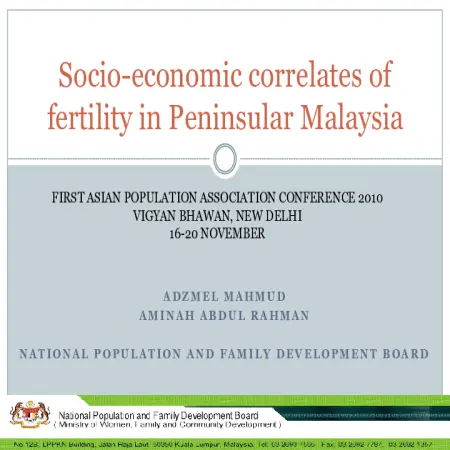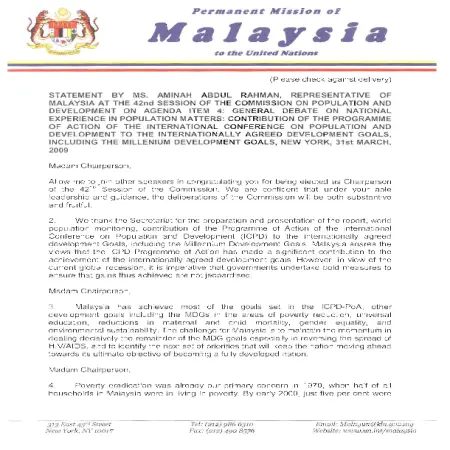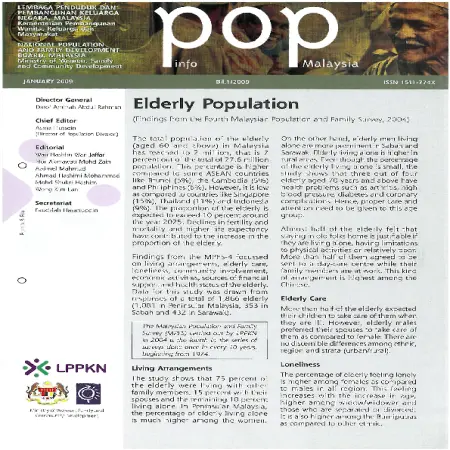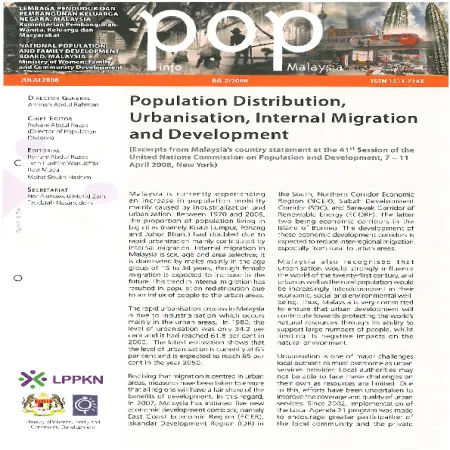TOPICS
Results for Topics : "Population"
|
|
Malaysia country report at 4th East Asia Ministerial Forum on Families, "Safe and resilient families: protecting and empowering at-risk and high risk families", Kuala Lumpur, 7-10 November 2010
Item Type: Country Statement
Editor:
Year: 00/00/2010
Abstract: Malaysia recognizes the family as a natural and fundamental
social unit that provides valuable human resource and forms the
backbone for solidarity, security and nation building. Malaysia
believes in the importance of family development in line with the
objective of creating a caring society ; Family is PRIORITY NO. 1
|
|
|
|
|
|
Socio-economic correlates of fertility in Peninsular Malaysia
Item Type: Conference or Workshop Item
Editor:
Year: 00/00/2010
Abstract: To examine fertility trends and differentials among women in Peninsular Malaysia by selected socioeconomic variables which significantly influence the number of children ever born. A total of 3,697 ever-married women aged 15-49 were successfully interviewed in Peninsular Malaysia.
|
|
|
|
|
|
Achieving the ICPD-PoA and MDGs
Item Type: Newsletter
Editor:
Year: 00/07/2009
Abstract: Malaysia has achieved most of the goals set in the ICPD-PoA. Other development goals included in the MDGs are in the areas of poverty reduction, universal education, reductions in maternal and child mortality, gender equality and environmental sustainability.
|
|
|
|
|
|
Socio-economic correlates of fertility in Peninsular Malaysia
Item Type: Thesis
Editor:
Year: 01/04/2009
Abstract: The main aim of this paper is to examine the fertility trends and differentials among Peninsular Malaysia women based on the 2004 Malaysian Population and Family Survey (MPFS-4) according to selected socio-economic variables which were found to have significant effect on number of children ever born. Findings from the study reveal that mean number of children ever born has dropped from 4.2 children in 1974 to 3.6 children in 1984, 3.4 children in 1994 and continued to decline to 3.1 in 2004. Fertility level is highest among Malays, who resides in rural areas, eastern region, lower educational level, women who had never worked, women whose husbands worked in agricultural sector and family income less than RM1000 a month. Socio-economic variables can only affect the fertility level through the intermediate variables such as postponement of marriage and use of contraception. There is an upward trend in age at first marriage from 17.6 years in 1974 to 22.0 years in 2004. Marriage postponement is more pronounced among highly educated Chinese women, followed by the Indians and the Malays. The contraceptive prevalence rate was highest among Chinese, followed by the Indians and the Malays. Ethnic differentials in number of children ever born are rather pronounced. In the multivariate context, after adjusting for age and age at first marriage, the differential in the mean number of children ever born among ethnic groups remain discernible. The socio¬economic variables have different effects on the fertility level of each ethnic group. 'Region' emerges as the most important predictor of Malay fertility, while 'work pattern' and 'family income' is the most important predictor of Chinese and Indian fertility respectively. Based on the present trend, it is highly likely that the fertility will reach replacement level by 2020, and the 70 million population target is unlikely to be achieved through natural increase. There is a need for the government to give some attention to the trend in delayed and non-marriage as this will determine to a large extent the future course of population growth in Malaysia.
|
|
|
|
|
|
The 42nd session of the Commission on Population and Development on agenda item 4: general debate on national experience in population matters: contribution of the programme of action of the international conference on population and development to the internationally agreed development goals, including the millenium development goals, New York, 31st March, 2009
Item Type: Country Statement
Editor:
Year: 31/03/2009
Abstract: Malaysia has achieved most of the goals set in the ICPO-PoA, other
development goals including the MDGs in the areas of poverty reduction, universal education, reductions in maternal and child mortality, gender equality, and
environmental sustainability. The challenge for Malaysia is to maintain the momentum in
dealing decisively the remainder of the MOG goals especially in reversing the spread of
HIV/AIDS, and to identify the next set of priorities that will keep the nation moving ahead towards its ultimate objective of becoming a fully developed nation.
|
|
|
|
|
|
Elderly population
Item Type: Newsletter
Editor:
Year: 00/01/2009
Abstract: The total population of the elderly (aged 60 and above) in Malaysia has reached to 2 million, that is 7 per cent out of the total of 27.6 million population. The proportion of the elderly is expected to exceed 10 per cent around the year 2025. Finding from the MPFS-4 focussed on living arrangements, elderly care, loneliness, community involvement, economic activities, sources of financial support and health status of the elderly. Data for this study was drawn from responses of a total of 1,866 elderly.
|
|
|
|
|
|
ICPD + 15 and MDGS: Malaysia's achievement and challenges
Item Type: Conference or Workshop Item
Editor:
Year: 00/00/2009
Abstract: Population and development are inextricably linked. The ICPD helped place population concerns at the heart of sustainable development. Meeting the needs of women and men rather than on achieving demographic targets. Interrelationships between population, sustained economic growth and sustainable development: Population factors incorporated into development planning. Poverty alleviation programmes since the 1st OPP. This slides presentation is talk about ICPD + 15 and MDGS: Malaysia’s achievement and challenges.
|
|
|
|
|
|
New Zealand indigenous people and resilience
Item Type: Conference or Workshop Item
Editor:
Year: 00/00/2009
Abstract: Indigenous peoples throughout the world have used strengths and resiliency to preserve the ongoing effects of colonizations and as tools for sovereignty. The 'Tangata Whenua' of New Zealand, along side other indigenous and minority groups throughout the world, continue to progress the development of their own cultural frameworks and models of practice. More recently in New Zealand, particularly within the health and social services sectors, 'tangata whenua' have begun to examine resiliency research and practices which contribute to the body of knowledge in the area of 'whanau ora', and the cultural capacities and capabilities which assist families to build resiliency and protective factors and processes. This presentation examines what has been learned from the theory and practice experiences of a 'Tangata Whenua' social work practitioner and trainer.
|
|
|
|
|
|
The 3rd East Asia Ministerial Forum on Families, "Strengthening family resilience: moving from policy to action",Bali Indonesia ,17-19 November 2008
Item Type: Country Statement
Editor:
Year: 00/11/2008
Abstract: The family institution performs multifaceted functions in the development and well-being of its members. In order to enable the family institution to fulfill its societal roles and responsibilities, it requires support from the state, civil society and from family members themselves. In this regard, it is essential that we examine
social services policies from the family and not just from the individual
perspective and whether they contribute towards the strengthening of
family resilience. Effective support and protection to families and their
individual members requires that services respond appropriately to the
needs that exist at different stages of the family lifecycle and the individual
lifespan.
|
|
|
|
|
|
Population distribution, urbanisation, internal migration and development
Item Type: Newsletter
Editor:
Year: 00/07/2008
Abstract: Malaysia is currently experiencing an increase in population mobility mainly caused by industrialization and urbanization. Between 1970 and 2006, the proportion of population living in big cities such as Kuala Lumpur, Penang and Johor Bharu had doubled due to rapid urbanization mainly contributed by internal migration. This trend in internal migration has resulted in population redistribution due to an influx of people to the urban areas.
|
|
|
|














